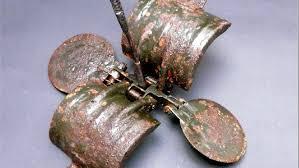
A Butterfly Bomb, or (Sprengbombe Dickwandig 2 kg or SD2) was a German 2 kilogram anti-personnel bomblet used by the German Luftwaffe during the Second World War. It was so named because the thin cylindrical metal outer shell hinged open when it was dropped and gave a superficial appearance of a large butterfly. The design was highly distinctive and easy to recognize. The SD2 bomblets were not dropped by themselves, but were used as the payload of various cluster bombs, such as AB 23 SD-2 and AB 250-3.
The bomblet was an 8 cm long cylinder which was slightly smaller in diameter before its vanes deployed. A steel cable 15 cm long was attached via a spindle to the fuze screwed into the fuze pocket in the side of the bomblet. The outer shell would hinge open as two half-cylinders when it was dropped and spring-loaded vanes at the ends would flip out. These rotated the spindle as the bomblet fell and armed the fuze. The bomblet could be fitted with any one of three fuzes:
41 fuze - detonated on impact
67 fuze - selectable time delay between 5 and 30 minutes
70 fuze - anti-handling, detonated if bomb was moved
Butterfly bombs contained 225 grams of TNT. They were generally lethal to anyone within a radius of 25 metres and could injure people as far away as 150 metres. Defusing butterfly bombs which had failed to detonate or which equipped with the anti-handling fuze was not considered practical. In such cases butterfly bombs were destroyed in situ.
Butterfly bombs were usually painted green. However, sometimes a dull yellow colour scheme was used, either for use in the middle east, or to drop on grain crops at harvest time to kill farm-workers.
On October 28, 1940, a butterfly bomb that was incompletely armed was discovered by British ordnance technicians Sgt. Cann and 2nd Lt. Taylor. By returning the arming rods they were able to recover the unit and dismantle it to learn more about how it functioned. The SD2 was disarmed by making a clay wall around the weapon and pouring liquid nitrogen over it, thus freezing the mercury spirit gauge that would activate the bomb once disturbed. The bomb was loaded onto a vehicle and safely disposed of.
They were packed into containers containing between 6 and 108 of the bombs, depending upon the container type, and were released as the container fell. This bomb type was the first cluster bomb ever used operationally.
It was most notably used in June 1943 against Grimsby and Cleethorpes in Great Britain, and subsequently in the Middle East. The British kept secret all the damage and disruption caused by these bombs so as not to encourage Germany to use them elsewhere.
The last recorded death from a German butterfly bomb in England took place on November 27, 1956, over 11 years after the Second World War ended. Flight Lieutenant Herbert Denning of the RAF was examining an SD2 at the Upminster bomb cemetery, East of RAF Hornchurch, when it exploded. He died of his injuries at Oldchurch Hospital the same day.
The United States manufactured a copy of the SD2 for use during the Korean War and Vietnam War, designating it the M83 Butterfly Bomb.